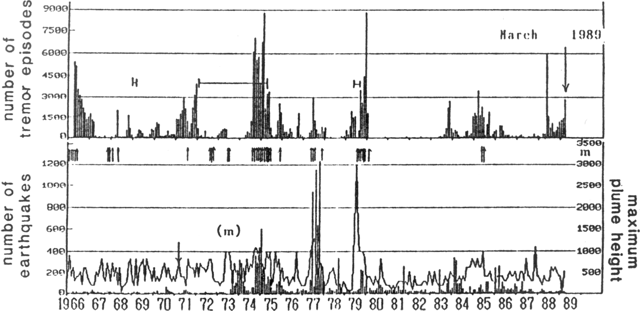Report on Asosan (Japan) — March 1989
Scientific Event Alert Network Bulletin, vol. 14, no. 3 (March 1989)
Managing Editor: Lindsay McClelland.
Asosan (Japan) Ash ejection; tremor increase; crater closed to tourists
Please cite this report as:
Global Volcanism Program, 1989. Report on Asosan (Japan) (McClelland, L., ed.). Scientific Event Alert Network Bulletin, 14:3. Smithsonian Institution. https://doi.org/10.5479/si.GVP.SEAN198903-282110
Asosan
Japan
32.8849°N, 131.085°E; summit elev. 1592 m
All times are local (unless otherwise noted)
About 3,000 volcanic tremor episodes were recorded during March, twice the number recorded in January and February (figure 9). A significant increase was recorded 22 March on a seismometer 0.8 km W of Crater 1. The amplitude of continuous tremor was generally unchanged.
Early 5 April, ash was ejected to ~50 m above a vent ~100 m below the crater rim. A field survey at 1140 the next day revealed that ash emission had stopped. A 1-km area (the smallest of three designated zones) around the crater was closed to tourists by the Aso Disaster Prevention Authority, at 0920 on 5 March. Such a restriction is necessary a few times a year when activity increases.
On 12 April, the restricted zone was reopened. Ash had not been ejected since 6 April although the frequency of tremor episodes remained high at 200/day. Glow at vents and cracks on the crater floor was regularly observed during night visits from October 1988 through April 1989.
Geological Summary. The 24-km-wide Asosan caldera was formed during four major explosive eruptions from 300,000 to 90,000 years ago. These produced voluminous pyroclastic flows that covered much of Kyushu. The last of these, the Aso-4 eruption, produced more than 600 km3 of airfall tephra and pyroclastic-flow deposits. A group of 17 central cones was constructed in the middle of the caldera, one of which, Nakadake, is one of Japan's most active volcanoes. It was the location of Japan's first documented historical eruption in 553 CE. The Nakadake complex has remained active throughout the Holocene. Several other cones have been active during the Holocene, including the Kometsuka scoria cone as recently as about 210 CE. Historical eruptions have largely consisted of basaltic to basaltic-andesite ash emission with periodic strombolian and phreatomagmatic activity. The summit crater of Nakadake is accessible by toll road and cable car, and is one of Kyushu's most popular tourist destinations.
Information Contacts: JMA.


